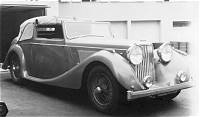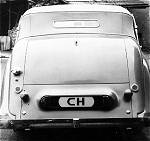| |||||||||||
| |||||||||||
|
Part II - A Jaguar is born1935/1936 was a watershed period and marked the first appearance of the word 'Jaguar' as a model name. Lyons is reputed to have chosen the name from a list of animals
whose names suggested power and elegance. His only problem was that the aircraft manufacturer Armstrong Siddeley were using the name for an aero engine but fortunately they readily agreed to Lyons' request
to use the name. Lyons also dreamt up a clever marketing ploy when unveiling the new 2.6L saloon car to the trade at the Mayfair Hotel in London.
He asked the guests how much they thought the car was going to cost and received around £600 as an average guess. He made his mark when
he announced the price as £385. This saloon completely dominated the new cars publicity to the extent that the sports saloon was almost unmentioned in the
press, a fact that may be difficult to understand today with the SS100 having almost cult status.
reputed to have chosen the name from a list of animals
whose names suggested power and elegance. His only problem was that the aircraft manufacturer Armstrong Siddeley were using the name for an aero engine but fortunately they readily agreed to Lyons' request
to use the name. Lyons also dreamt up a clever marketing ploy when unveiling the new 2.6L saloon car to the trade at the Mayfair Hotel in London.
He asked the guests how much they thought the car was going to cost and received around £600 as an average guess. He made his mark when
he announced the price as £385. This saloon completely dominated the new cars publicity to the extent that the sports saloon was almost unmentioned in the
press, a fact that may be difficult to understand today with the SS100 having almost cult status.
The 1935-37 models had a single wing mounted spare tyre while the 1938-40 models had the tyre kept under the boot in a compartment. The radiator shell has vertical chrome bars. The front sidelights on early cars are a separate chrome unit, but on later cars were done by welding a pod onto the wing and blending in with lead. Horns are generally visible, mounted on the bumper or under the headlights. Some cars have foglights. The door handles are below the chrome side trim on early cars, but in line with the trim on later cars. The tires are 18 inch rim diameter with wire spoke wheels, with the chromed knock-off hub having the SS logo. The optional Ace discs covered the spokes to give the appearance of disc wheels. There were a few special bodies done by various other coachbuilders including Graber, Saoutchik, Beuttler, Van den Plas, and a Mulliner divided limosine for Standard's director Sir John Black. The SS100 Coupe
With production at record levels, the Second World War then intervened and SS Cars moved to wartime production. Walter Hassan had now joined the team and during fire watching duties, their thoughts turned to a new power unit - what was to become the famous XK engine was conceived during this period. After the war, production resumed but with the company now renamed Jaguar Cars Ltd since the old SS now had sinister associations for most people. A contemporary 1945 advert annnounced the change to the world at large. The SS100 was dropped and in fact never resumed production. A total of 24 S.S.90s, 198 2.7L SS100s and 116 3.5L SS100s were made (49 SS100s were exported). Between 1935 and 1940, SS Cars produced a total of 6227 vehicles.
Post war
 The resumed production post-war models were all now 'Jaguars' but with a reduced range - two engine sizes and a single saloon body style. In 1947, a drop head coupe joined the range,
available with 2.5 and 3.5L engines as was the saloon.
These models are usually known as the 'Mark IVs' although this was never an official Browns Lane factory designation as far as is known.
However, a USA brochure from 1964 for the Mark X does refer to this range as the Mark IV in its introductory history.
The resumed production post-war models were all now 'Jaguars' but with a reduced range - two engine sizes and a single saloon body style. In 1947, a drop head coupe joined the range,
available with 2.5 and 3.5L engines as was the saloon.
These models are usually known as the 'Mark IVs' although this was never an official Browns Lane factory designation as far as is known.
However, a USA brochure from 1964 for the Mark X does refer to this range as the Mark IV in its introductory history.
|
|
| ||
 |
Improve your Jag-lovers experience with the Mozilla FireFox Browser!
©Jag-loversTM Ltd / JagWEBTM 1993 - 2024 All rights reserved. Jag-lovers is supported by JagWEBTM For Terms of Use and General Rules see our Disclaimer Use of the Jag-lovers logo or trademark name on sites other than Jag-lovers itself in a manner implying endorsement of commercial activities whatsoever is prohibited. Sections of this Web Site may publish members and visitors comments, opinion and photographs/images - Jag-lovers Ltd does not assume or have any responsibility or any liability for members comments or opinions, nor does it claim ownership or copyright of any material that belongs to the original poster including images. The word 'Jaguar' and the leaping cat device, whether used separately or in combination, are registered trademarks and are the property of Jaguar Cars, England. Some images may also be © Jaguar Cars. Mirroring or downloading of this site or the publication of material or any extracts therefrom in original or altered form from these pages onto other sites (including reproduction by any other Jaguar enthusiast sites) without express permission violates Jag-lovers Ltd copyright and is prohibited |
 |